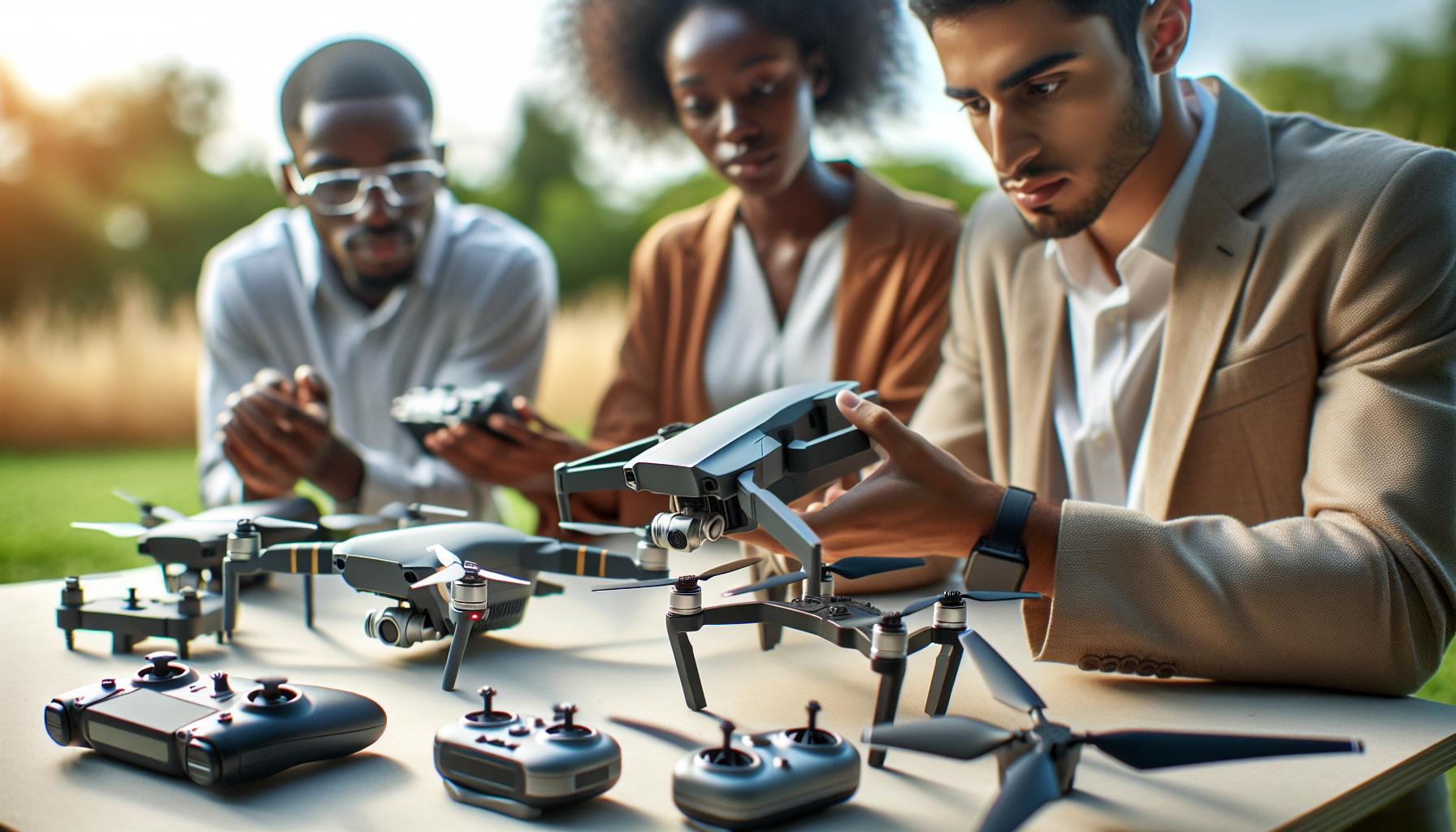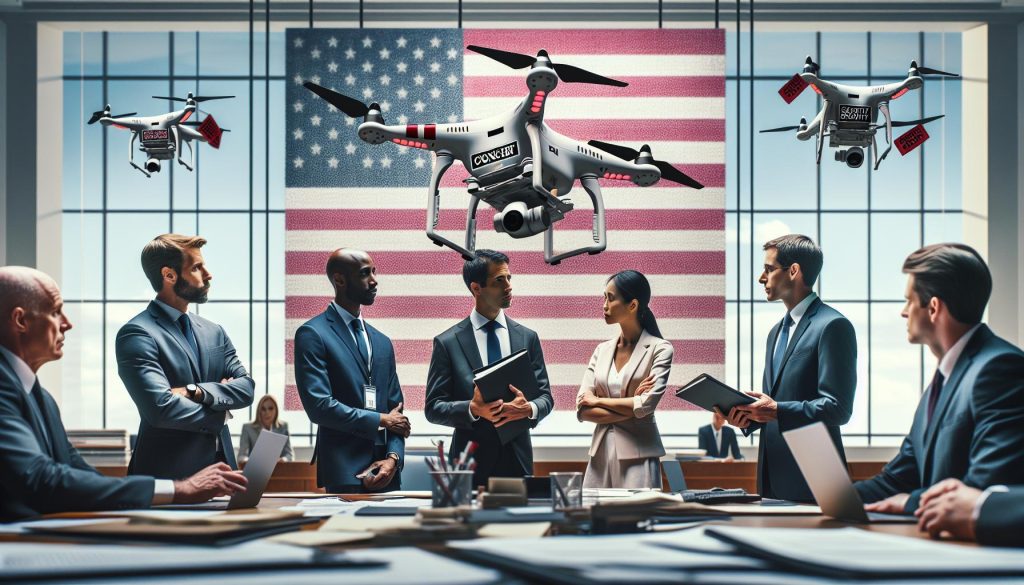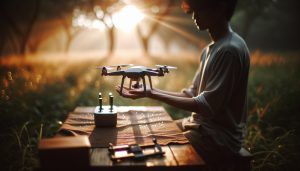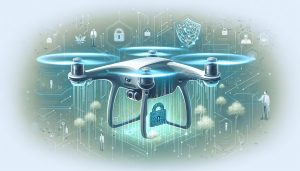Did you know that drone technology has rapidly transformed various industries, from photography to agriculture? However, as the popularity of drones like those manufactured by DJI burgeoned, so did concerns over national security. The U.S. government’s decision to ban DJI drones stems from fears of data security and potential espionage threats, raising crucial questions for both hobbyists and professionals alike. Understanding the reasons behind this ban is essential for drone operators who must navigate a changing landscape of regulations, ensuring safety and compliance while maximizing their flying experience. Dive in as we explore the intricate layers of this issue, addressing your concerns and providing insights into what this means for the future of drone technology in the U.S.
Understanding the US Government’s DJI Drone Ban
As drone technology continues to evolve, the concerns surrounding safety and data privacy are taking center stage, particularly regarding DJI drones. The U.S. government’s potential ban on these widely used drones stems largely from national security considerations. Reports of substantial ties between DJI and the Chinese government have raised alarms over the possibility of sensitive data being accessed or misused. This unease isn’t limited to government agencies; private sectors, including industries that heavily rely on drones for critical applications like agriculture and emergency response, are also impacted.
The upcoming Section 1709 provisions under the National Defense Authorization Act (NDAA) signals an impending shift, potentially leading to an outright ban on the sale of DJI drones within the U.S. Market experts warn that this could disrupt the operations of thousands of users who depend on DJI drones for their work. Specifically, sectors such as construction, surveying, and emergency services could find themselves scrambling for alternatives as the supply of DJI products dwindles and support for existing equipment becomes uncertain [[1]](https://www.thedroneu.com/blog/updating-the-dji-drone-ban-what-you-need-to-know-about-section-1709-of-the-fy25-ndaa/) [[2]](https://dronedj.com/2025/06/17/dji-ban-6-months-deadline/).
In addition to the implications for professional users, hobbyists are equally affected by this regulatory shift. Not only do they face limitations on purchasing new DJI models, but they may also contend with restrictions on flying existing drones due to updated legal frameworks around drone operations. Users need to stay informed about changing regulations to ensure compliance while navigating the evolving landscape of drone technology. As public discourse around UAV regulation intensifies, understanding the U.S. government’s stance will be crucial for current and prospective drone operators alike.
Key Security Concerns Behind the Ban
The origin of growing concern regarding DJI drones can be traced back to issues of national security, particularly relating to data security and privacy. As one of the largest drone manufacturers globally, DJI has established a significant market share, especially within the United States. However, the company’s alleged ties to the Chinese government have raised red flags among U.S. lawmakers and intelligence agencies. The potential for sensitive information captured by DJI drones, such as real-time data from critical infrastructure or commercial operations, to be accessed by foreign entities has sparked fierce debate on the safety of using these devices for both personal and professional purposes.
Concerns Surrounding Data Privacy
At the heart of the security debate is the fear of data leakage. DJI drones typically store and transfer data through cloud-based systems that could theoretically be accessible by external malicious entities. Reports have suggested that the data collected could include detailed mapping information, flight patterns, and images of sensitive locations. In sectors where confidentiality is paramount, such as law enforcement or national defense, the potential exposure of such information represents a vulnerability that cannot be ignored. This concern has prompted talks of stricter regulations and the potential for a ban on the company’s products in the U.S. market.
Government Reports and Legislative Action
Multiple government entities, including the Department of Defense, have issued reports suggesting that using DJI drones poses a risk not only to national security but also to personal privacy. In response to these findings, Congress has relied on legislation like the Countering CCP Drones Act, which aims to counter perceived threats from foreign-owned drones in critical sectors. Such measures underscore the U.S. commitment to safeguarding sensitive data and establishing a stronger, self-reliant domestic drone industry.
As DJI continues to face scrutiny, the conversation around security is evolving, emphasizing the need for comprehensive regulations that balance innovation in drone technology with robust measures to protect national security interests. Hence, as drone operators consider their options, an informed understanding of these critical security concerns can guide their purchasing decisions and operational practices.
Impact of the Ban on DJI and Consumers
The potential U.S. ban on DJI drones could have significant repercussions for both the company and its customers. As one of the industry leaders, DJI’s sudden exit from the American market would not only erase a diverse range of products from consumer options but also disrupt workflows for many professionals who rely on these drones for their operations. Companies in sectors such as agriculture, construction, and filmmaking, which have come to depend on DJI’s robust technology for aerial photography, mapping, and surveying, face the daunting task of pivoting to alternative solutions that may not offer the same reliability or features.
For consumers, the ripples from a DJI ban extend beyond availability. It may lead to increased prices and a potential decrease in the quality of drone technology offered by alternatives. The highly competitive nature of the drone market has historically driven innovation and accessibility, driven largely by DJI’s technological advancements. A reduction in market competition can result in diminished consumer choice and make it harder for hobbyists and professionals to procure affordable, feature-rich drones. Furthermore, the anxiety surrounding data privacy may push more consumers toward less familiar but potentially less secure solutions, raising questions about the protection of their own data during flight.
Moreover, transitioning from DJI to other brands may necessitate a steep learning curve for users accustomed to the ergonomics and interfaces of DJI products. Many drone enthusiasts and professionals cite the user-friendliness and extensive support of DJI models. Therefore, the shift could not only disrupt daily operations but also require re-training in some cases, impacting productivity and operational efficiency.
Ultimately, the looming ban on DJI drones underscores broader concerns about national security and privacy. As companies and enthusiasts navigate their alternatives, awareness of these factors is critical. While there is no denying that this ban could create challenges, it also opens the door for new opportunities for innovation among domestic drone manufacturers, potentially reshaping the landscape of the drone industry in response to growing security concerns.
Current Alternatives to DJI Drones
As the U.S. government’s ban on DJI drones prompts users to search for alternatives, several brands have stepped up to fill the void, offering a range of options suitable for both hobbyists and professionals. These alternatives vary in features, pricing, and capabilities, but they exemplify the ongoing innovation in the drone industry, ensuring users can still achieve their aerial goals without compromising on quality.
Prominent Alternatives to Consider
Among the leading competitors is Autel Robotics, which offers the EVO series known for its impressive camera capabilities and user-friendly interface. The EVO Lite and EVO Lite+ come equipped with robust features such as 4K video recording, long flight times, and advanced obstacle avoidance. Users frequently praise these drones for their exceptional image quality, making them a strong alternative for photographers and videographers dissatisfied with the potential loss of DJI products.
Parrot is another noteworthy competitor, especially with its Anafi and ANAFI USA models. The Anafi, designed for hobbyists, boasts an ultra-compact design, 4K HDR video, and a tiltable camera, allowing for unique shooting angles. Parrot’s ANAFI USA, on the other hand, targets business and professional users, integrating thermal imaging capabilities and AI-enhanced features that cater to industries like construction and search and rescue operations.
Skydio has gained considerable attention for its advanced autonomous flying capabilities. The Skydio 2, often lauded for its obstacle avoidance and tracking abilities, appeals to those requiring a reliable drone for dynamic environments, such as following fast-moving subjects or capturing complex outdoor shots. Its intuitive controls and seamless app integration also make it a favorite among users seeking a hassle-free flying experience.
What’s Next for the Drone Market?
The vacuum created by the DJI ban may accelerate innovation among other manufacturers. Users may find emerging brands, like Yuneec and Holy Stone, stepping into the spotlight with cost-effective models that offer essential features for recreational use. While these brands may not match the high-end specs of DJI, they can provide great alternatives for casual flyers and those focused on entry-level drone experiences.
It’s crucial for users transitioning from DJI to research these alternatives thoroughly. Consider factors like camera specifications, software compatibility, battery life, and after-sales support. Engaging with user forums and reviews can also provide valuable insights into the day-to-day experience of flying these drones, helping to ensure a smooth transition to a new brand that meets individual needs and expectations.
As the drone landscape adapts, users are likely to see not just an evolution in existing products but also new innovations in drone technology driven by competitive pressures. Embracing these alternatives can lead not only to satisfying flying experiences but also to the support of a more diverse drone market.
The Role of Surveillance and Data Privacy
The ongoing conversation surrounding drone usage and regulation is increasingly intertwined with issues of surveillance and data privacy, particularly in the context of the U.S. government’s ban on DJI drones. Concerns primarily stem from the potential for foreign entities, specifically Chinese companies like DJI, to collect sensitive data through their devices. This risk becomes particularly pertinent in applications involving government, law enforcement, and critical infrastructure, where the collection and transmission of data could lead to national security threats.
In light of these concerns, it’s essential for drone operators-both hobbyists and professionals-to understand what data their devices may collect. DJI drones, for instance, often require a connection to the internet for operational features and updates, which raises questions about data handling and storage practices. Users should be vigilant about the permissions granted during app installations and the network connections established. To mitigate privacy risks, operators can take proactive steps, such as:
- Utilizing Local Storage: Whenever possible, configure drones to store data locally, rather than transmitting it to remote servers, thereby limiting exposure.
- Verifying Software: Regularly check for and apply firmware updates that may address data security vulnerabilities or enhance privacy settings.
- Restricting App Permissions: Limit permissions for apps associated with drone operations, ensuring they only access necessary features without gathering excessive personal data.
- Engaging with Privacy Policies: Carefully review privacy policies from drone manufacturers to understand their data handling practices.
The shift in public sentiment towards responsible drone usage reflects a broader demand for transparency in how surveillance capabilities are utilized. This aligns with a growing awareness of data rights among consumers, and many are increasingly prioritizing brands that are committed to ethical data practices. Companies that address these privacy concerns proactively may distinguish themselves in a competitive market, fostering consumer trust in an era where personal data security is paramount.
As the U.S. seeks to balance the advancement of drone technology with national security interests, understanding these dynamics becomes crucial for operators. Staying informed about revisions in drone regulations and potential shifts in the technology landscape will empower users to make educated choices, ensuring they fly responsibly while navigating the intricate relationship between surveillance capabilities and data privacy.
Legal and Regulatory Framework Governing Drones
Navigating the intricate landscape of drone regulations is essential for all operators, especially with the looming U.S. ban on DJI drones due to national security concerns. Drone regulation in the United States is primarily governed by the Federal Aviation Administration (FAA), which has established guidelines for the operation, classification, and airworthiness of drones. The FAA’s framework incorporates both federal and local regulations, creating a patchwork that requires operators to stay informed and compliant.
Every drone operator must adhere to Part 107 of the FAA regulations if they are flying for commercial purposes, which mandates certifications, operational limitations, and maintenance of visual line-of-sight. Equally, hobbyist pilots are required to follow Recreational UAS Safety Guidelines, which promote safe flying practices but don’t necessitate formal certification. This diverse regulatory environment means that operators must understand the specific rules applicable to their usage scenario, especially as the government considers the implications of foreign-made drone technology on public safety and national security.
To ensure compliance, drone users should actively monitor changes to regulations that may impact their flying privileges. Drawing attention to DJI’s situation, the ongoing discussions around its potential ban highlight the need for operators to explore alternatives. It also emphasizes the importance of engaging with proper documentation, maintaining updated flight logs, and adhering strictly to local airspace restrictions.
In addition to federal regulations, local laws may impose further restrictions on where and how drones can be operated. Operators should familiarize themselves with state and municipal codes, especially concerning privacy rights and airspace accessibility. For example, flying over sensitive areas, such as schools or government buildings, may be strictly prohibited or require special permission. The governance of drone operations cannot be overstated; successful navigation through this legal framework not only ensures compliance but also contributes to safer skies for everyone.
By understanding and integrating these regulatory guidelines into their operations, drone pilots can enhance their flying practices while remaining informed of the ever-evolving legal landscape affecting their craft. This knowledge is pivotal in fostering not only personal safety but also broader acceptance of drone technologies within the public sphere.
Responses from DJI and the Drone Community
As tensions mount regarding the future of DJI drones in the United States, responses from both the company and the broader drone community reflect a mix of frustration, concern, and determination to find solutions. DJI has staunchly defended itself against accusations related to national security, highlighting its commitment to transparency and the safety of its products. The company asserts that its drones utilize robust security protocols to protect user data and privacy. In various statements, DJI has called on regulators to base their decisions on facts, emphasizing that a ban could stifle innovation and limit the advancements in drone technology that benefit consumers and industries alike.
The drone community’s reaction includes a blend of skepticism and support. Many operators express concern over the implications of the ban, not just for DJI but for the entire industry. The alternatives to DJI drones may not fully meet the needs of professional users, raising questions about the performance and capabilities of competing brands. Strong support for DJI can be seen in online forums and social media groups, where pilots share their experiences and encourage one another to advocate for the brand. This solidarity highlights the integral role DJI plays in the creative and commercial aspects of drone flying, from aerial photography to search-and-rescue operations.
In response to the potential ban, several advocacy groups have begun to mobilize, urging lawmakers to reconsider actions that could jeopardize technological progress and user needs. They argue that instead of an outright ban, the government should enhance oversight and regulation of drone technology, including establishing clear benchmarks for safety and security across all brands. This dialogue underscores the importance of participatory governance in shaping the future landscape of drone operations.
Understanding the nuances of these responses can empower drone operators to engage thoughtfully in discussions surrounding drone regulations. Staying informed, collaborating with other pilots, and participating in community forums can amplify their voices and influence policymakers. Ultimately, the trajectory of DJI products in the U.S. market will significantly impact not just the company and its users, but the entire realm of drone technology.
International Reactions to the US Ban
The U.S. government’s decision to ban DJI drones has resonated across the globe, prompting reactions from various countries and their drone communities. While the ban reflects U.S. concerns about national security and data privacy, it has also ignited a broader conversation about the implications of such measures on international trade, technological innovation, and global collaboration in the drone industry.
Countries like Canada and Australia have shown a keen interest in the U.S. stance but have not yet mirrored the ban. Canadian aviation authorities are conducting their assessments of DJI products, weighing the potential risks alongside the benefits those drones provide to sectors like agriculture and emergency response. Conversely, Australia has continued to permit DJI drones, though the Australian government has issued guidelines aimed at enhancing security standards for drone technology, highlighting a more measured approach to drone regulation.
In Europe, reactions have ranged from cautious to supportive of the U.S. action. The European Union has been tightening data privacy laws, which resonates with the U.S. ban’s emphasis on security. However, some EU nations maintain close ties with DJI and acknowledge the significant role DJI products play in creative industries and public safety operations. This has led to calls for a more balanced approach-one that ensures data privacy while still supporting technological advancement and local innovation in the drone sector.
The global drone community is also vocal about this topic, expressing concerns that such bans may lead to increased fragmentation of the industry. Many stakeholders argue that the best way forward involves collaboration and open dialogue between countries, manufacturers, and regulators to establish baseline security standards that all drone technologies must meet, regardless of their country of origin. This perspective stresses the potential of drones to facilitate humanitarian efforts, environmental monitoring, and disaster response-in tasks that transcend borders and foster international cooperation.
As the discourse continues, it remains crucial for drone operators worldwide to stay informed about policy changes and explore alternative technologies that align with the evolving regulatory landscapes in their regions. Consideration of both security and operational needs will be key as nations navigate the complexities introduced by such bans, aiming for a future where innovation can thrive under secure frameworks.
Future Implications for Drone Technology
The global drone landscape is on the brink of significant transformation in the wake of the U.S. government’s ban on DJI drones. As market leaders like DJI face stringent restrictions, there is a growing impetus for innovation and diversification within the drone technology sector. This presents an opportunity for manufacturers to develop alternative solutions that not only comply with emerging regulatory frameworks but also address consumer needs for high-quality aerial technology.
In this evolving environment, we can anticipate a surge in domestic drone manufacturing as the U.S. seeks to enhance its self-reliance in critical technological sectors. This shift could lead to collaborations among local startups and established companies, resulting in innovations that integrate advanced features-such as enhanced safety protocols, improved data security measures, and unique functionalities designed for specific industries. For instance, agricultural drones might incorporate specialized sensors for precision farming, while drones used in public safety could be equipped with advanced imaging technology to aid first responders.
Moreover, the ban raises important questions about the future of drone regulations worldwide. Policymakers may soon need to craft comprehensive legislative frameworks that define standards for drone safety, cybersecurity, and operational transparency. These regulations are essential for fostering a secure operating environment where drone technology can thrive. As nations engage in dialogue around these issues, they might harmonize standards to facilitate international drone operations and encourage the sharing of innovations that support cross-border initiatives-such as disaster response and environmental monitoring.
For consumers and pilots, this shift towards alternative drone options necessitates a reevaluation of choices in the marketplace. As new players enter the industry, consumers will benefit from increased competition, likely resulting in a greater variety of models and features tailored to their specific flying preferences and needs. Expect to see drones equipped with enhanced data encryption, longer flight times, and superior camera capabilities as manufacturers strive to attract those previously loyal to DJI. Engaging with these new alternatives not only empowers users to make informed purchasing decisions, but also supports a broader movement towards secure and innovative drone technology that prioritizes safety and privacy.
Consumer Awareness: Choosing Safe Drone Options
Flying a drone has never been more thrilling and accessible, but with the recent U.S. ban on DJI drones due to security concerns, consumers are left pondering how to choose safe and reliable alternatives. One crucial factor to consider is the importance of data security and privacy. Select drones that prioritize protecting user data. Look for manufacturers that offer strong encryption and have transparent privacy policies, ensuring that your data isn’t exploited or shared without your consent.
Additionally, consider the regulatory landscape. With the potential for evolving laws governing drone use, choose brands that demonstrate compliance with U.S. regulations and are proactive in their approach to legal standards. Drones equipped with features like geo-fencing not only help you fly responsibly by preventing access to restricted areas but also conform to local and federal guidelines.
When exploring alternatives, look into reputable drone manufacturers that offer reliable customer support and warranty programs. Below are some recommended brands and models to consider:
- Parrot Anafi USA – Focused on both professional use and personal safety, this drone incorporates advanced imaging technology.
- Skydio 2 – Known for its impressive autonomous flying capabilities, particularly in obstacle avoidance, making it an excellent option for adventure enthusiasts.
- Autel Robotics EVO Lite+ – Offers a good balance of quality and affordability, with impressive camera capabilities.
It’s also wise to invest in drones with user-friendly interfaces and solid tutorials or community support. This allows you to navigate setup smoothly and ensures assistance is readily available if you encounter issues. Platforms like YouTube or drone forums can provide invaluable resources for troubleshooting and learning advanced flying techniques.
In summary, while the ban on DJI drones may seem daunting, it opens the door to a wealth of new, innovative options. By prioritizing security features, staying informed about regulations, and choosing reputable manufacturers, you can confidently select a drone that suits your needs while prioritizing your safety and privacy.
How to Navigate the DJI Drone Ban
Navigating the changing landscape of drone regulations, especially in the wake of the U.S. ban on DJI drones, may seem overwhelming. However, equipping yourself with the right knowledge and strategies can empower you to adapt swiftly and effectively. First, it’s essential to stay updated on the current regulations surrounding drone use, as the legal landscape can evolve rapidly. Monitoring reliable sources, such as government websites and sanctioned drone advocacy groups, will keep you informed about any changes that could affect your ability to fly legally and safely.
One effective approach is to familiarize yourself with alternative drone brands that prioritize security and compliance. Models from manufacturers like Parrot, Skydio, and Autel Robotics have emerged as viable options that can replace DJI drones while also meeting safety and data privacy standards. Explore these options thoroughly by reviewing specifications, user experiences, and expert recommendations to optimize your purchase decision without compromising on the features you need.
In addition, creating a flying community or networking with other drone enthusiasts can be invaluable. Online forums and local meetups can provide support and resources to discuss best practices in drone operation and the latest news about the DJI situation. Engaging in conversations can often lead to tips on troubleshooting and enhancements shared by fellow pilots, broadening your understanding of alternative drones and flight techniques.
Lastly, always ensure that your new drone adheres to necessary legal frameworks, such as registering with the FAA and understanding airspace restrictions. Incorporating tools and features like geo-fencing can aid in compliance and contribute to safer drone operations. As you navigate this new chapter in drone flying, prioritizing education, community engagement, and compliance will not only alleviate concerns over the ban but also enhance your overall flying experience.
Best Practices for Flying Non-DJI Drones
Flying non-DJI drones can open up a wider world of possibilities, especially in light of the recent U.S. government ban on DJI products due to security concerns. Embracing alternative brands not only allows you to continue enjoying drone photography or videography, but it also encourages a more diverse and resilient drone market. To ensure a successful transition and maintain a high standard of flight safety, consider the following best practices.
First and foremost, always familiarize yourself with the specific features and capabilities of your new drone. Not all drones operate the same way, and understanding the particular nuances of your model-whether it’s a Parrot, Skydio, or Autel-is essential for effective operation. Dive into the user manual, explore online resources, and watch tutorials that are often available through the manufacturer’s website or drone enthusiast communities. This proactive approach will not only boost your confidence but also help you utilize advanced features like GPS tracking or obstacle avoidance effectively.
Next, prioritize regular maintenance and firmware updates. Keeping your device up-to-date enhances functionality and security, safeguarding your flight experience. Establish a routine maintenance schedule that includes checking for any physical damages, cleaning the camera lens, and testing the battery health. Many drone manufacturers provide robust support forums where you can find information on common issues and maintenance tasks. Engaging with these resources can significantly enhance your flying experience while keeping your drone in optimal condition.
Moreover, emphasizing compliance with legal regulations is crucial. Each drone operator must understand local and federal regulations governing drone use, including no-fly zones and altitude restrictions. Register your drone with the FAA if required, and ensure your flying practices adhere to established guidelines. To aid in compliance, consider using tools such as drone apps that provide real-time airspace information, allowing you to plan your flights legally and safely.
Lastly, cultivating community connections can dramatically enrich your flying knowledge and skills. Joining online forums or local drone clubs encourages the sharing of insights on best flying practices, tips about alternative parts, and collaborative opportunities for aerial projects. Whether it’s discussing the latest models or troubleshooting flight issues, engaging with other drone enthusiasts will keep you informed and inspired. This community interaction nurtures continuous learning and fosters a positive environment in which all pilots can thrive.
With these strategies, you can confidently navigate your experiences with non-DJI drones, ensuring safe and fulfilling outdoor adventures while embracing the shift in the drone landscape.
Q&A
Q: Why did the US government decide to ban DJI drones?
A: The US government banned DJI drones primarily due to security concerns, specifically fears about data privacy and the potential for unauthorized data collection by the Chinese government, which could pose risks to national security.
Q: What security risks are associated with DJI drones?
A: DJI drones raise security risks related to data transmission and surveillance capabilities. Concerns include the potential for sensitive information to be accessed by foreign entities through backdoor data collection or insecure communication channels.
Q: How does the DJI ban affect drone users and consumers?
A: The ban impacts drone users by limiting their access to popular and often affordable DJI models. Consumers may need to seek alternatives, which could be more expensive or lacking in features offered by DJI products.
Q: What alternatives exist to DJI drones following the ban?
A: Alternatives to DJI drones include brands such as Parrot, Autel Robotics, and Skydio, which offer various models with competitive features. Users should assess these options based on their specific needs and budget.
Q: What legal measures support the US ban on DJI drones?
A: The legal framework for the DJI drone ban includes federal regulations citing national security risks. The ban aligns with broader US efforts to restrict technology perceived as a threat from adversarial nations as outlined in various executive orders and legislation.
Q: What has been DJI’s response to the US ban?
A: DJI has publicly denied allegations of wrongdoing and emphasized its commitment to user data privacy. The company has initiated efforts to improve transparency and engage with regulators to address security concerns.
Q: What do experts say about the future of DJI drones post-ban?
A: Experts predict that while DJI will face challenges in the US market, it may adapt by enhancing data security measures or pivoting to markets with fewer restrictions. The long-term impact will depend on evolving regulations and consumer sentiment.
Q: How can consumers ensure drone safety amid regulations?
A: Consumers can ensure safety by researching drone models, focusing on brands with strong security records, and following local regulations regarding drone usage. Engaging with communities and forums for up-to-date information on compliance is also beneficial.
Concluding Remarks
As we’ve explored, the US ban on DJI drones stems from significant national security concerns that are reshaping the drone landscape. Understanding the implications of these security issues is crucial for both current and prospective drone users. If you’re concerned about the impact on your flying experiences or future purchases, don’t hesitate to dive deeper into our latest articles on DJI drone alternatives and effective security practices.
Ready to make informed decisions? Check out our detailed guides on drone setup and legal compliance to ensure you’re always flying responsibly. Join our newsletter for continuous updates, expert tips, and the latest news in the drone world! Your engagement not only helps you navigate this evolving field but also keeps the community vibrant and informed. Share your thoughts below, and let’s keep the conversation going about the future of drone technology.










